You’ll discover that Michigan’s native plants have adapted to survive everything from sandy lakeshores to dense woodland floors over thousands of years. These hardy species don’t just tolerate the state’s unpredictable weather patterns, they actually thrive in conditions that would kill most garden center varieties. Whether you’re dealing with clay soil that stays soggy for weeks or sandy patches that drain faster than you can water them, there’s a native solution waiting.
Contents
- 1 Michigan’s Soil and Water Conditions
- 2 Michigan’s Best Native Wildflowers
- 3 Michigan’s Shade and Canopy Trees
- 4 Michigan’s Best Native Shrubs
- 5 Selecting the Right Native Plants for Your Garden
- 6 Frequently Asked Questions
- 6.1 When Is the Best Time to Plant Native Species in Michigan?
- 6.2 How Do I Control Invasive Species When Establishing Native Plants?
- 6.3 What Are the Maintenance Requirements for Established Native Plant Gardens?
- 6.4 Where Can I Purchase Native Michigan Plants and Seeds Locally?
- 6.5 How Long Does It Take for Native Plants to Become Established?
Michigan’s Soil and Water Conditions
When you’re selecting native plants for your Michigan landscape, understanding your soil becomes the foundation for gardening success. Michigan’s diverse soil associations create distinct growing conditions across the state. You’ll find sandy soils like Oakville-Plainfield types drain rapidly but offer low water capacity, making them challenging for moisture-loving plants.
Loamy soils, including Brady-Wasepi associations, retain water better with moderate permeability. These soils support more diverse plantings. Your soil’s drainage directly affects plant survival, so test your specific site before choosing natives that’ll thrive in your unique conditions.
Each soil series is named after a nearby geographical feature, helping you identify the specific characteristics of your local growing conditions.
Michigan’s Best Native Wildflowers
Michigan’s native wildflowers provide year-round beauty and ecological benefits, blooming from early spring through late fall while supporting pollinators, birds, and butterflies in diverse habitats. These plants are essential for maintaining Michigan’s vast biodiversity, as the loss of one species can accelerate the decline of dependent species throughout the ecosystem.
Wild Bergamot (Monarda Fistulosa)
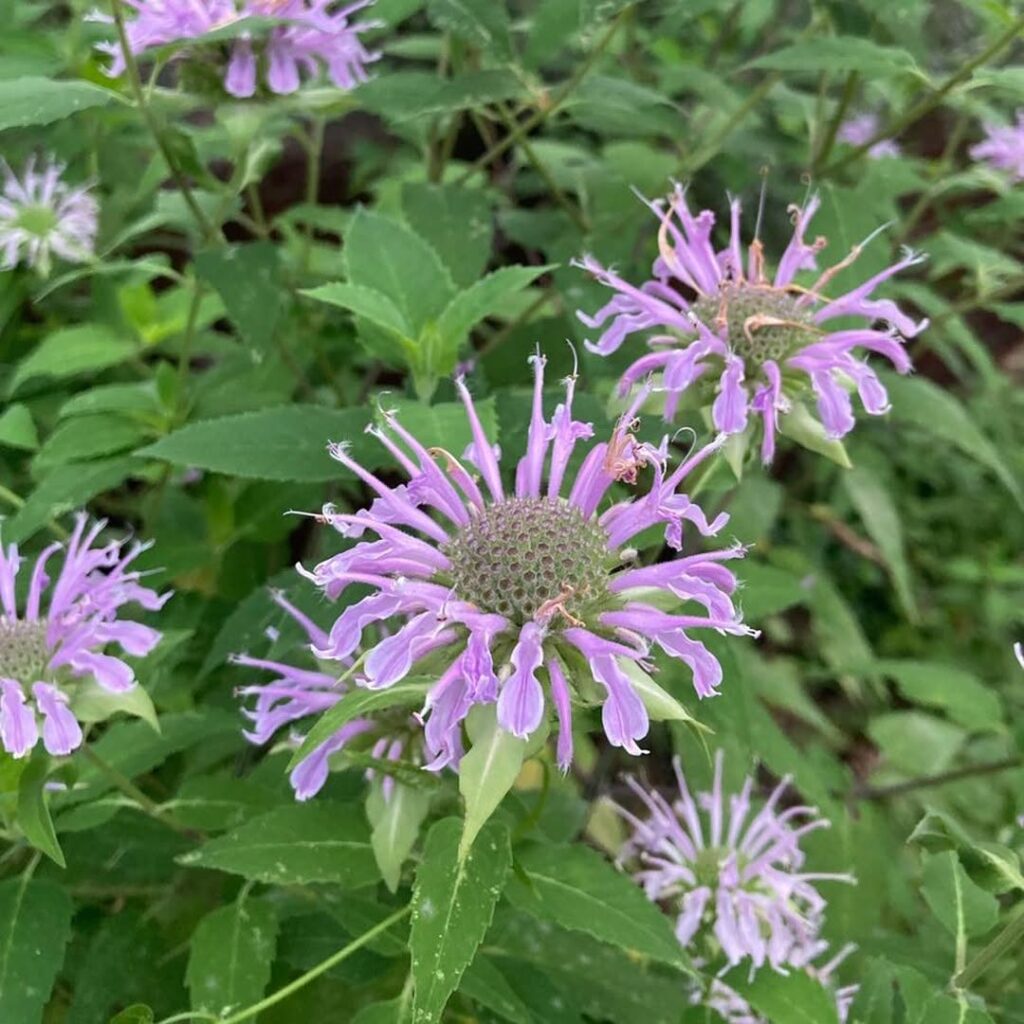
Wild Bergamot is a native Michigan perennial that brings exceptional value to pollinator gardens with its aromatic, tubular flower clusters in shades of violet, pink, and white. Blooming from late June through August, this 2-3 foot tall member of the mint family features distinctive square, hairy stems and emits a pleasant minty fragrance. Its long flowering period and drought tolerance make it an excellent low-maintenance choice for native plant gardens.
This hardy wildflower attracts an impressive array of pollinators including native bees, butterflies, and hummingbirds, earning recognition as a valuable monarch nectar plant. Wild Bergamot thrives in well-drained soils and full sun conditions while demonstrating deer resistance and erosion control benefits. The plant can be aggressive and may outgrow its designated space in a few seasons, requiring gardener intervention to manage its spreading nature.
- Hardiness: USDA zones 3-9
- Light: Full sun preferred, tolerates some shade (6+ hours ideal)
- Water: Drought tolerant once established; dry to medium moisture
- Soil: Well-drained loamy, sandy, rocky, or clay soils; pH 6.0-7.5
- Fertilizer: Not required; thrives in native conditions
- Pest/Disease Resistance: Deer resistant; susceptible to powdery mildew in dense plantings
- Growth Rate: Medium; reaches 2-3 feet tall at maturity
Wild Columbine (Aquilegia Canadensis)
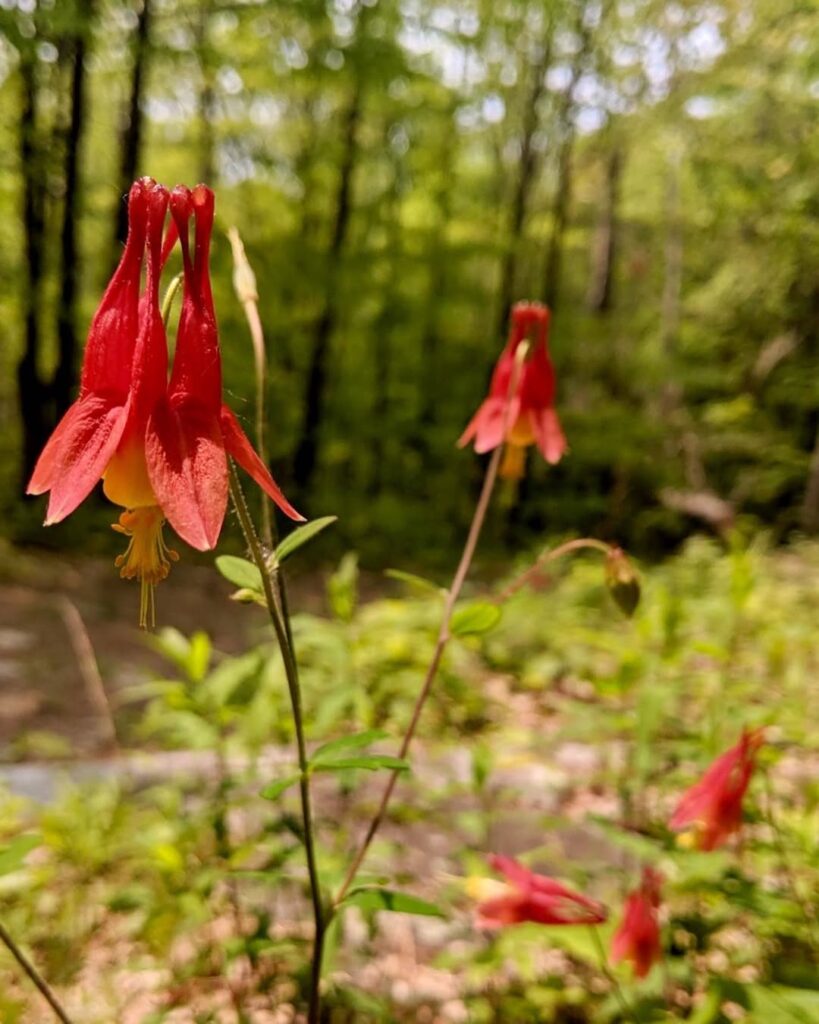
Wild Columbine (Aquilegia canadensis) is a charming native perennial wildflower that graces Michigan’s landscapes with its distinctive bell-shaped blooms. Growing up to 3 feet tall, this member of the buttercup family produces nodding flowers with striking red exterior sepals and bright yellow petals from April through June. The plant’s unique appearance and early blooming period make it a standout addition to woodland gardens.
This adaptable wildflower thrives in Michigan’s diverse growing conditions, from full sun to deep shade. Wild Columbine naturally occurs throughout eastern North America and plays an important ecological role by attracting early-arriving hummingbirds and various native bee species. Its ability to grow in multiple soil types and moisture conditions makes it an excellent choice for naturalized areas and shade gardens. The plant produces tan follicles as its fruit type, which develop approximately two weeks after the flowers emerge.
- Hardiness: USDA zones 3a-8b
- Light: Full sun to full shade
- Water: Medium to dry conditions; prefers moist, organically rich soil
- Soil: Adaptable to muck, clay, loam, or sand; thrives in organically rich soil
- Fertilizer: Low requirements; benefits from organic matter
- Pest/Disease Resistance: Generally resistant with proper growing conditions
- Growth Rate: Medium growth rate throughout growing season
Michigan Lily (Lilium Michiganense)
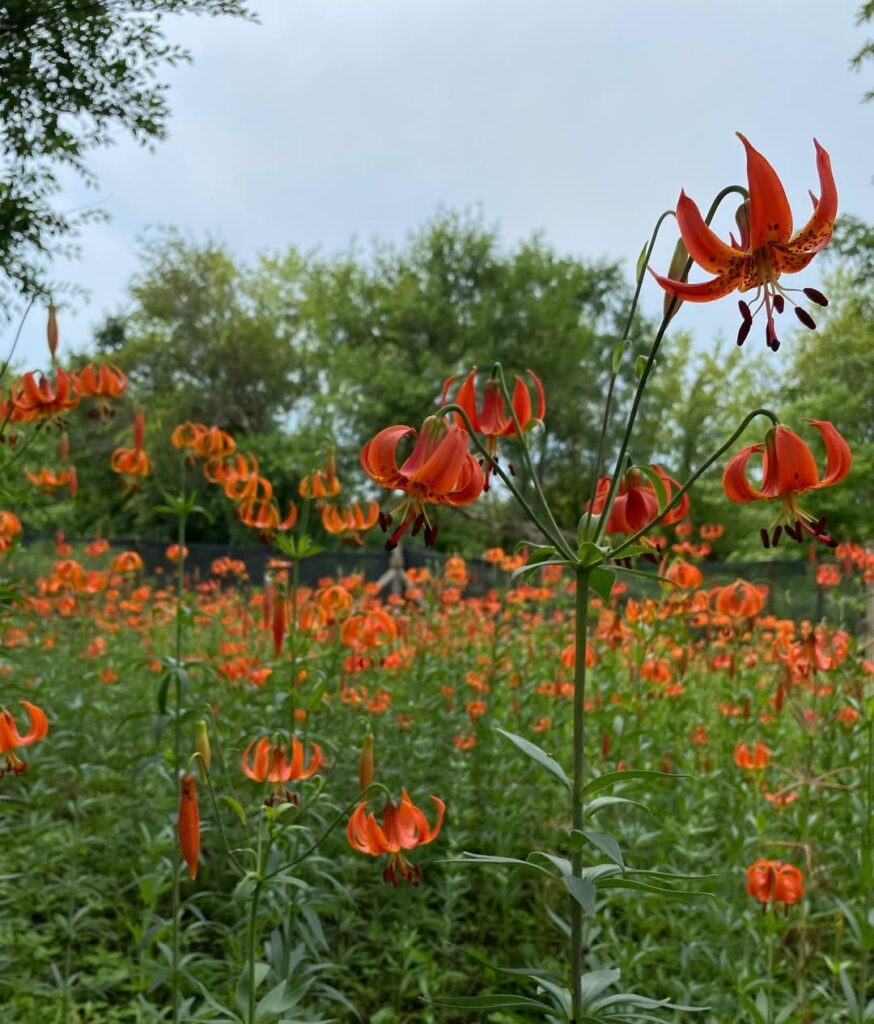
The Michigan Lily is a striking native perennial that graces the Great Lakes region with its distinctive deep orange, spotted flowers in July. Growing 3-6 feet tall with characteristic whorled leaves, this elegant wildflower produces backward-curving petals that resemble a Turk’s Cap. Found naturally in moist prairies, woodland openings, and along streams, it serves as a jewel in native landscapes.
This impressive lily thrives in quality natural habitats from Bur Oak savannas to swampy meadows. While challenging to establish from seed, it rewards patient gardeners with years of stunning blooms that attract hummingbirds, sphinx moths, and butterflies. Once established, it can form small colonies and persist for decades, making it an excellent low-maintenance addition to perennial borders and water gardens. Seeds contain built-in dormancy mechanisms that prevent immediate germination and require special treatment to break their natural rest period.
- Hardiness: Great Lakes region and Upper Mississippi Valley zones
- Light: Full to partial sun
- Water: Medium to wet soil conditions; can tolerate some drought once established
- Soil: Moist black soil, loamy soil, sandy loam, or clay with adequate moisture
- Fertilizer: Low requirements; excessive fertilizer causes plants to flop over
- Pest/Disease Resistance: No serious insect or disease problems; bulbs may be eaten by voles
- Growth Rate: Slow from seed; somewhat faster from bulbs or transplants
Wild Lupine (Lupinus Perennis)
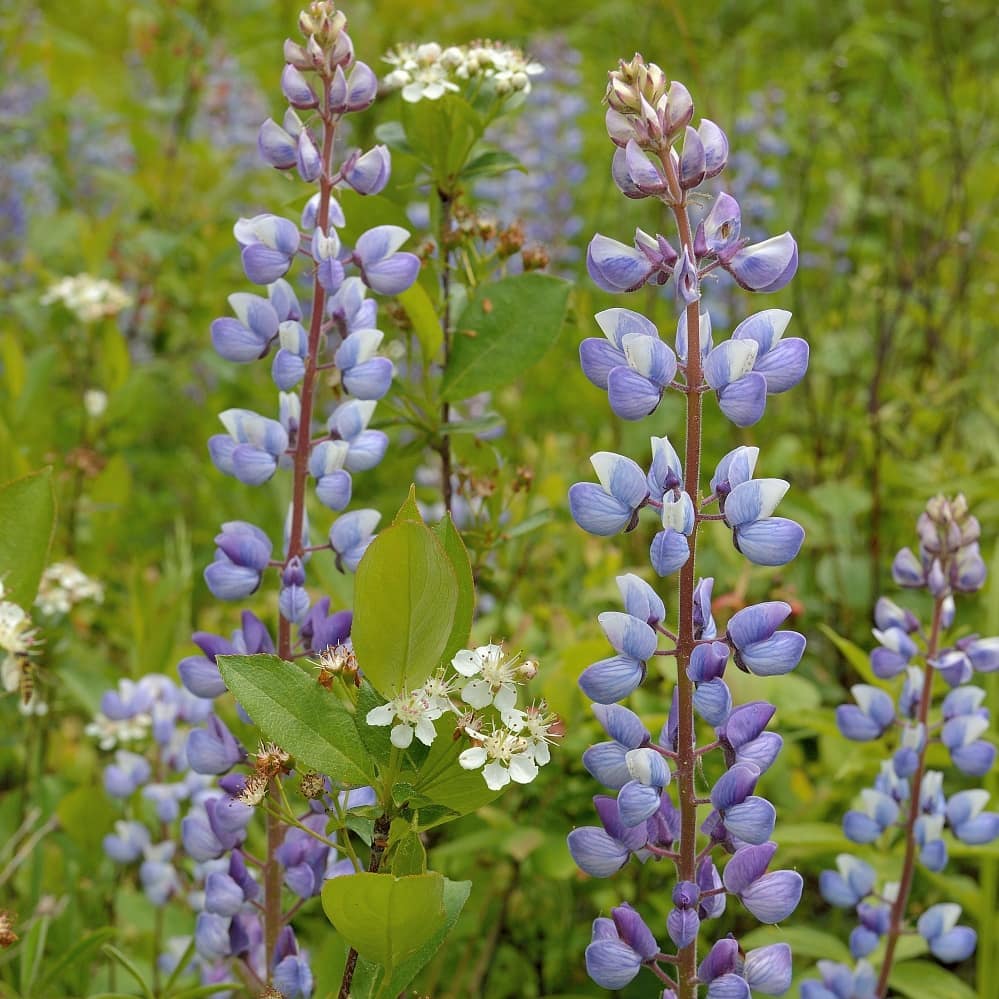
Wild Lupine (Lupinus perennis) is a stunning perennial wildflower native to Michigan that grows up to 2 feet tall with distinctive compound palmate leaves featuring 7-11 leaflets. This clumping wildflower produces fragrant blue to purplish flower spikes from May to July, creating striking vertical interest in the landscape.
Once abundant throughout Michigan’s black oak sand savannas, Wild Lupine has become less common due to fire suppression practices. The plant develops hairy seed pods that naturally disperse seeds when mature, making it excellent for naturalized wildflower gardens and native plant landscapes that can accommodate its 10-18 inch spread. Wild Lupine serves as an important pollinator magnet, attracting bees and butterflies to its vibrant blue blossoms throughout the flowering season.
- Hardiness: USDA zones 3-8
- Light: Full sun to partial shade; benefits from partial shade in hotter regions
- Water: Moderate; tolerates dry conditions, allow soil to dry between waterings
- Soil: Well-drained, acidic, sandy, or loamy soil; tolerates clay if well-draining
- Fertilizer: Low requirements; thrives in poor soils
- Pest/Disease Resistance: Generally resistant when grown in appropriate conditions
- Growth Rate: Slow
Trout Lily (Erythronium Americanum)
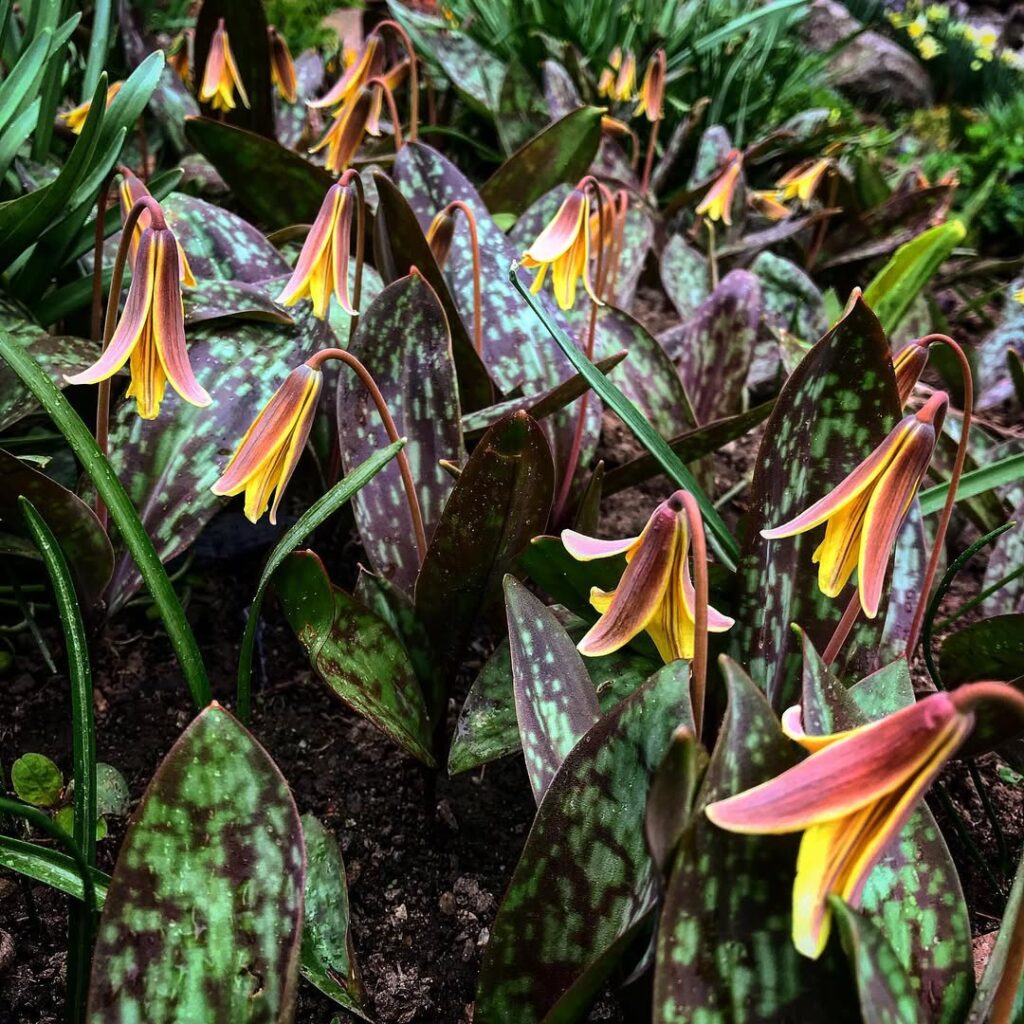
Trout Lily is a charming spring ephemeral native to Michigan’s deciduous woodlands. This perennial herb grows 3-12 inches tall and is easily recognized by its distinctive mottled leaves marked with maroon-brown spots that resemble brook trout patterns. In April, mature plants produce a single, nodding yellow flower with backward-curving petals.
The plant forms extensive colonies through underground corms, providing early-season nectar for pollinators before the forest canopy fully develops. As a true spring ephemeral, both leaves and flowers disappear by mid-summer. Trout Lily serves as an indicator of healthy, undisturbed woodland ecosystems and is excellent for native plant gardens that mimic natural forest floor conditions. The species benefits from ant dispersal of its seeds, which helps establish new colonies in suitable woodland habitats.
- Hardiness: USDA zones 3-9, native throughout Michigan
- Light: Partial shade to dappled sunlight; blooms before tree canopy closure
- Water: Consistent moisture; prefers well-drained but not dry conditions
- Soil: Rich, humus-rich, loamy soil with good drainage
- Fertilizer: None needed; thrives in naturally fertile woodland soils
- Pest/Disease Resistance: Excellent; rarely affected by pests or diseases
- Growth Rate: Slow to establish initially, then spreads steadily through vegetative reproduction
Michigan’s Shade and Canopy Trees
Michigan’s shade and canopy trees form the backbone of woodland ecosystems, providing essential habitat while supporting forest restoration through their remarkable adaptations and ecological benefits. These native species demonstrate better survival rates during Michigan’s harsh winters and extreme weather events compared to non-native alternatives.
Eastern White Pine (Pinus Strobus)
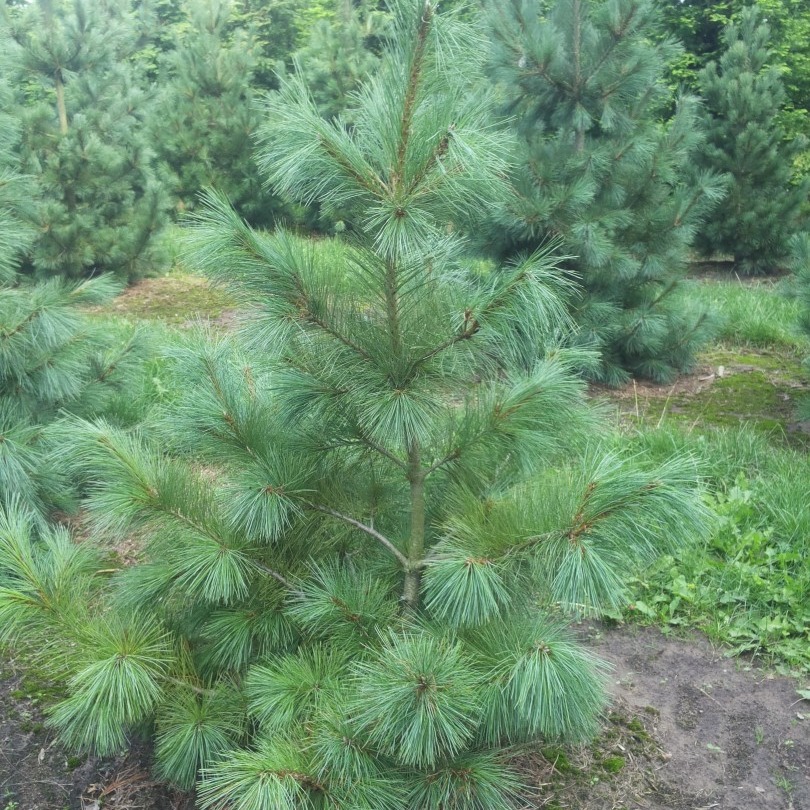
The Eastern White Pine is Michigan’s largest native conifer, distinguished by its soft, light green needles growing in bundles of five and characteristic horizontal branching pattern. This fast-growing species features smooth, pale grey bark on young trees that darkens and furrows with maturity. Green cones develop on long stalks with thin scales.
As one of the more rapid-growing northern conifers, Eastern White Pine provides excellent shade and canopy coverage for both natural and residential landscapes. The species offers substantial ecological benefits, sequestering over 41 pounds of CO2 and preventing nearly 289 gallons of stormwater runoff over 20 years. Its fire resistance and reseeding ability make it valuable for reforestation projects throughout Michigan. For optimal user experience when researching this species online, botanical databases and plant identification websites typically require modern browser capabilities.
- Hardiness: Zones 3-8, well-suited for Michigan’s climate
- Light: Full sun to partial shade
- Water: Moderate moisture requirements, drought tolerant once established
- Soil: Well-drained soils, adaptable to various soil types
- Fertilizer: Low maintenance, typically does not require fertilization
- Pest/Disease Resistance: Susceptible to white pine blister rust; generally hardy
- Growth Rate: Fast-growing among northern forest conifers
Eastern Red Oak (Quercus Rubra)
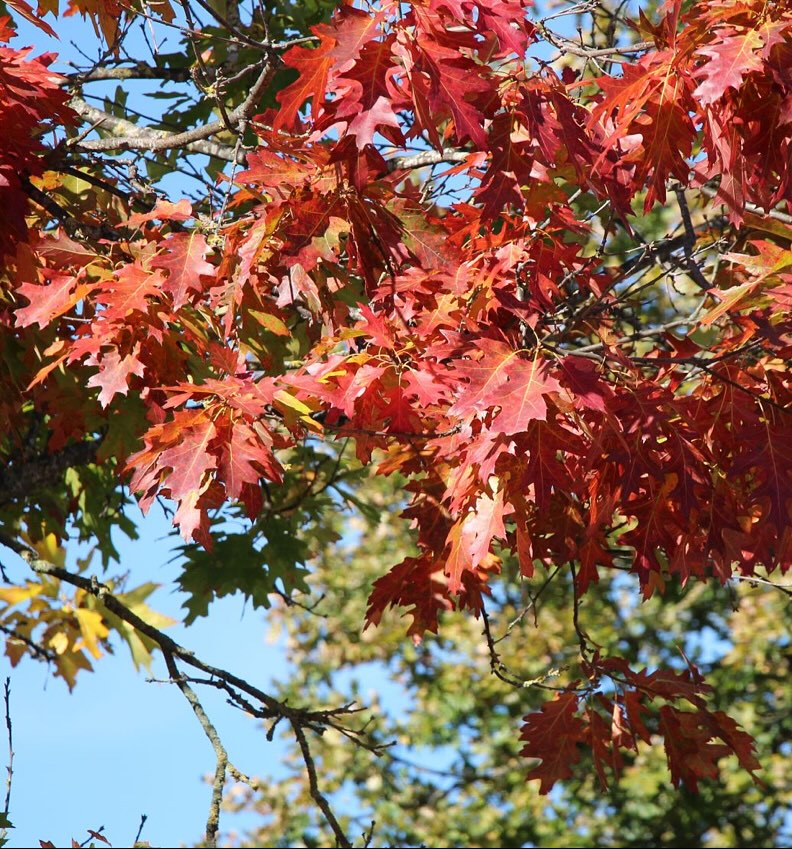
The Eastern Red Oak (Quercus rubra) is a magnificent native Michigan tree that serves as an excellent choice for shade and canopy coverage. This fast-growing oak can reach heights of 60-75 feet with a distinctive round-topped crown formed by stout branches extending at right angles. Its deeply lobed leaves with pointed tips create beautiful red and bronze fall colors, while its gray, ridged bark adds winter interest.
As a member of the beech family, the Eastern Red Oak produces large, barrel-shaped acorns that provide essential food for wildlife, though they’re more bitter than white oak acorns due to higher tannin content. This long-lived tree can survive up to 400 years and is valued both for its ecological benefits and practical uses, including high-quality lumber for furniture and flooring. The species serves as a host plant for various butterfly larvae including Imperial moth and hairstreaks, making it valuable for supporting local pollinator populations.
- Hardiness: Zones 3-7, well-suited to Michigan’s climate
- Light: Full sun to partial shade
- Water: Moderate; drought tolerant once established
- Soil: Acidic, fertile, well-drained sandy to loamy soils
- Fertilizer: Generally not needed in suitable soil conditions
- Pest/Disease Resistance: Good; tolerates air pollution and black walnut
- Growth Rate: Moderate to fast; 16-20 feet in 10 years
Sugar Maple (Acer Saccharum)
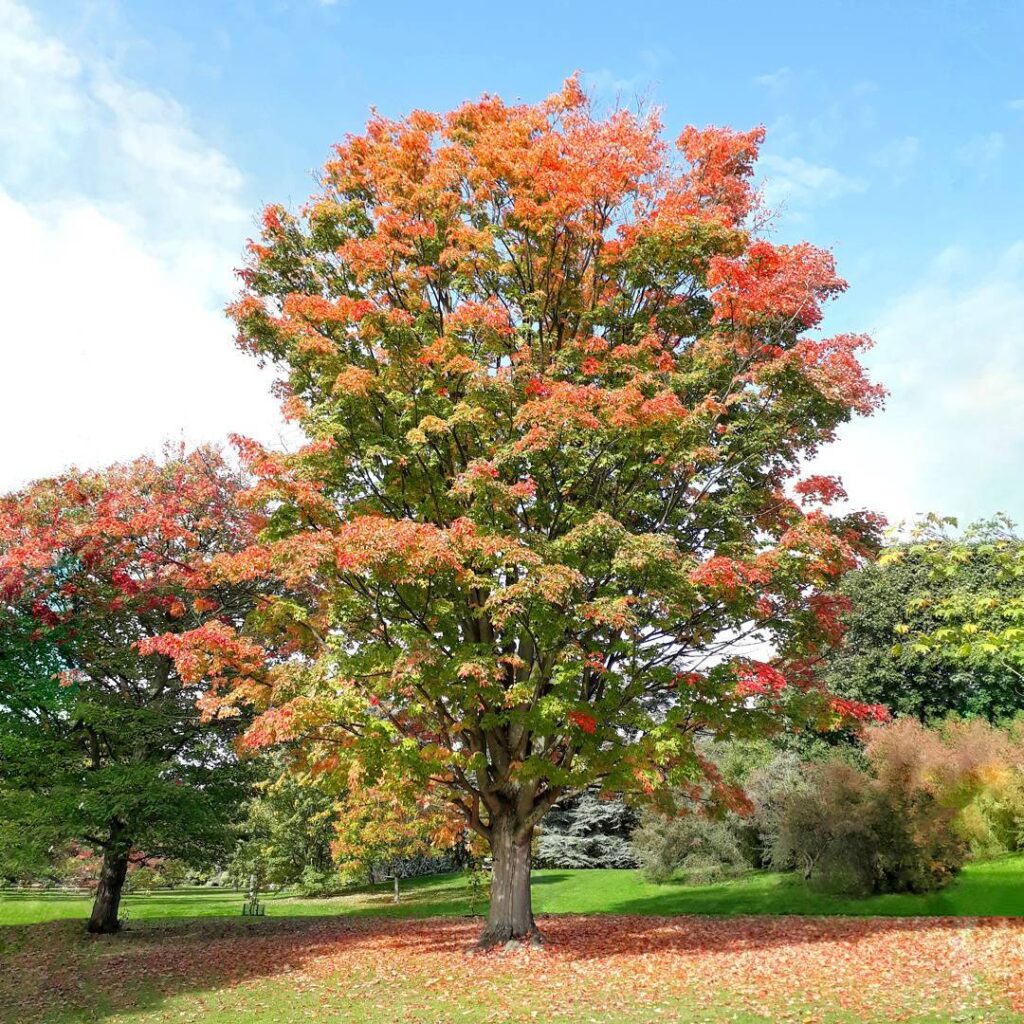
The Sugar Maple (Acer saccharum) stands as one of Michigan’s most iconic native trees, reaching impressive heights of 60-75 feet at maturity. Distinguished by its five-lobed leaves that showcase brilliant yellow, orange, and red autumn colors, this species serves dual purposes as both a stunning landscape specimen and the primary source of maple syrup production in Michigan.
Beyond its ornamental value, the Sugar Maple plays an essential ecological role in Michigan’s forests, providing food and habitat for wildlife including deer, rabbits, chipmunks, and squirrels. Its shade tolerance makes it an excellent choice for understory planting, while its strong root system and adaptability to Michigan’s climate zones guarantee reliable establishment and long-term success in native landscapes. Sugar Maples demonstrate remarkable longevity with typical lifespans of 200-300 years, making them valuable generational investments for Michigan properties.
- Hardiness: Zones 3-8, well-suited to Michigan’s climate
- Light: Shade to partial shade for peak growth
- Water: Moderate moisture requirements, drought tolerant once established
- Soil: Adaptable to various soil types, develops strong root system
- Fertilizer: Low maintenance, typically does not require supplemental feeding
- Pest/Disease Resistance: Generally hardy with good natural resistance
- Growth Rate: Moderate to slow growth rate, long-lived specimen
American Basswood (Tilia Americana)
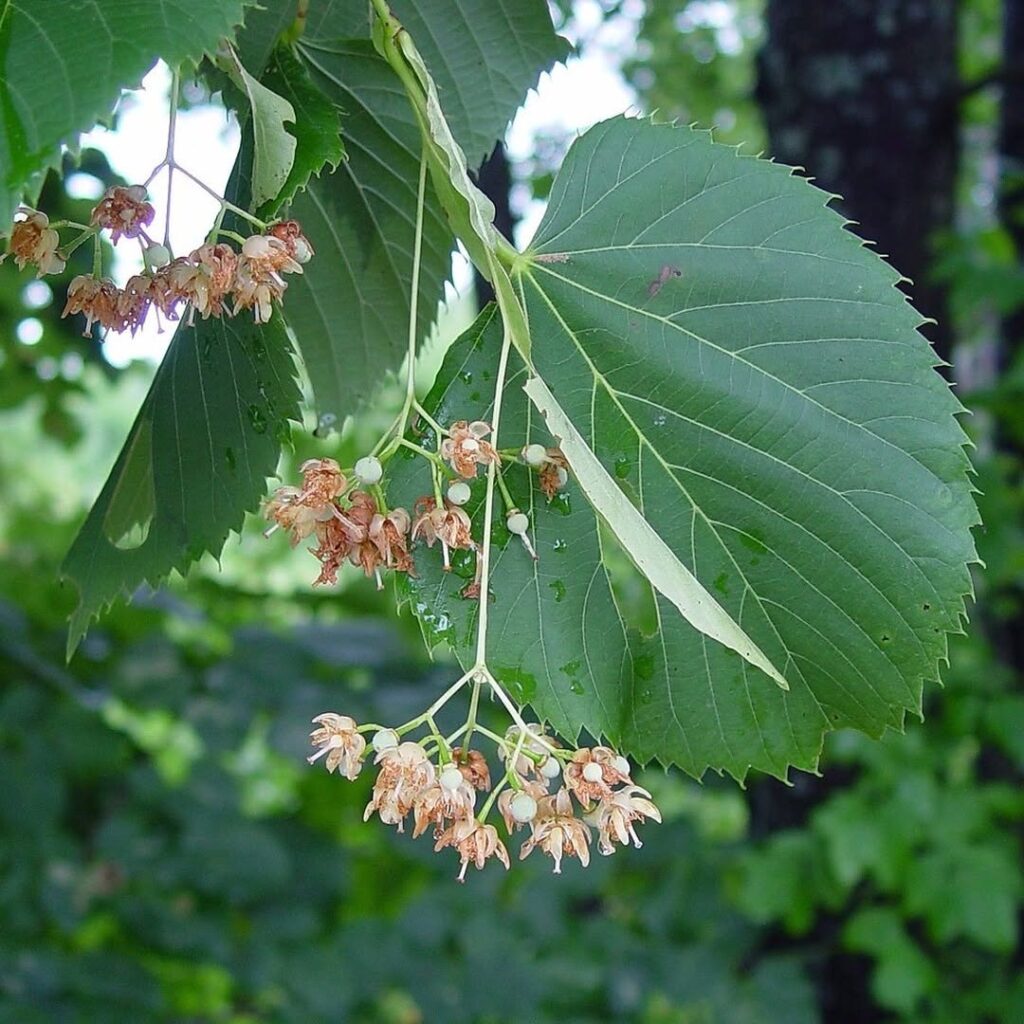
American basswood is a majestic native tree that serves as an excellent canopy species for Michigan landscapes. Growing 60-100 feet tall, this rapid-growing tree features distinctive heart-shaped leaves and produces fragrant, creamy flowers in late spring that earn it the nickname “Bee-tree.” The soft wood and fibrous inner bark have been valued for centuries by Native Americans for rope-making and crafts.
This versatile shade tree thrives in Michigan’s climate and provides exceptional ecological value. Its abundant nectar supports bees, butterflies, and other pollinators, while birds utilize both the seeds for food and the soft wood for nesting cavities. The tree’s tolerance for urban conditions makes it popular for landscaping, though it tends to develop multiple trunks and sprouts readily at the base. The flowers also produce a strongly flavored honey that is particularly favored by beekeepers.
- Hardiness: Zones 3-8
- Light: Full sun to partial shade
- Water: Moist, well-drained; tolerates drought once established
- Soil: Deep, moist soils preferred; pH 6.5-8.2
- Fertilizer: Not specified
- Pest/Disease Resistance: Susceptible to Japanese beetles, mites, aphids, borers, leafminers, and scales
- Growth Rate: Rapid
Eastern Hemlock (Tsuga Canadensis)
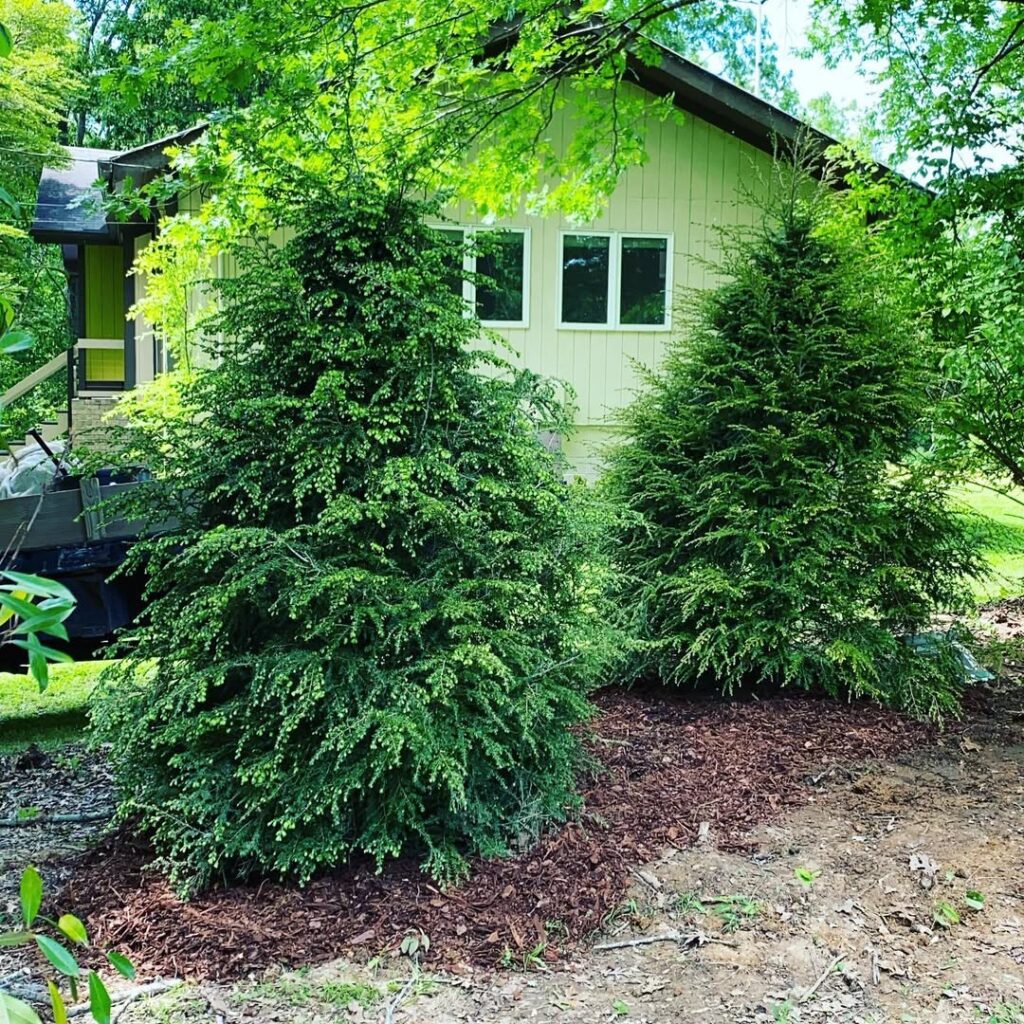
The Eastern Hemlock is Michigan’s graceful evergreen conifer, distinguished by its soft, flat needles with white undersides and distinctive pyramid shape. Growing 70-100 feet tall with drooping branch tips and reddish-brown scaly bark, this native species produces small hanging cones that provide food for wildlife.
As a cornerstone of Michigan’s forest ecosystems, Eastern Hemlock creates cool, moist microclimates essential for understory plants like ferns and mosses. It serves as critical habitat for songbirds, provides nesting sites for warblers, and offers year-round shelter for deer and small mammals. However, populations face serious threats from the invasive hemlock woolly adelgid. These trees are considered preferred deer browse and may require protective measures when establishing young specimens in areas with high deer populations.
- Hardiness: USDA zones 3-8, well-suited to Michigan’s climate
- Light: Partial sun to shade; highly shade tolerant
- Water: Consistent moisture required; prefers well-drained but moist conditions
- Soil: Acidic, well-draining soils with good organic content
- Fertilizer: Low requirements; benefits from organic mulch and compost
- Pest/Disease Resistance: Susceptible to hemlock woolly adelgid; generally disease resistant
- Growth Rate: Slow to moderate growth; long-lived species
Michigan’s Best Native Shrubs
Michigan’s diverse climate supports exceptional native shrubs suited for wet and dry conditions, offering multi-season beauty, low maintenance requirements, and essential wildlife habitat throughout the state. These plants require reduced water use compared to non-native alternatives, making them an environmentally responsible choice for sustainable landscaping.
Elderberry (Sambucus Canadensis)
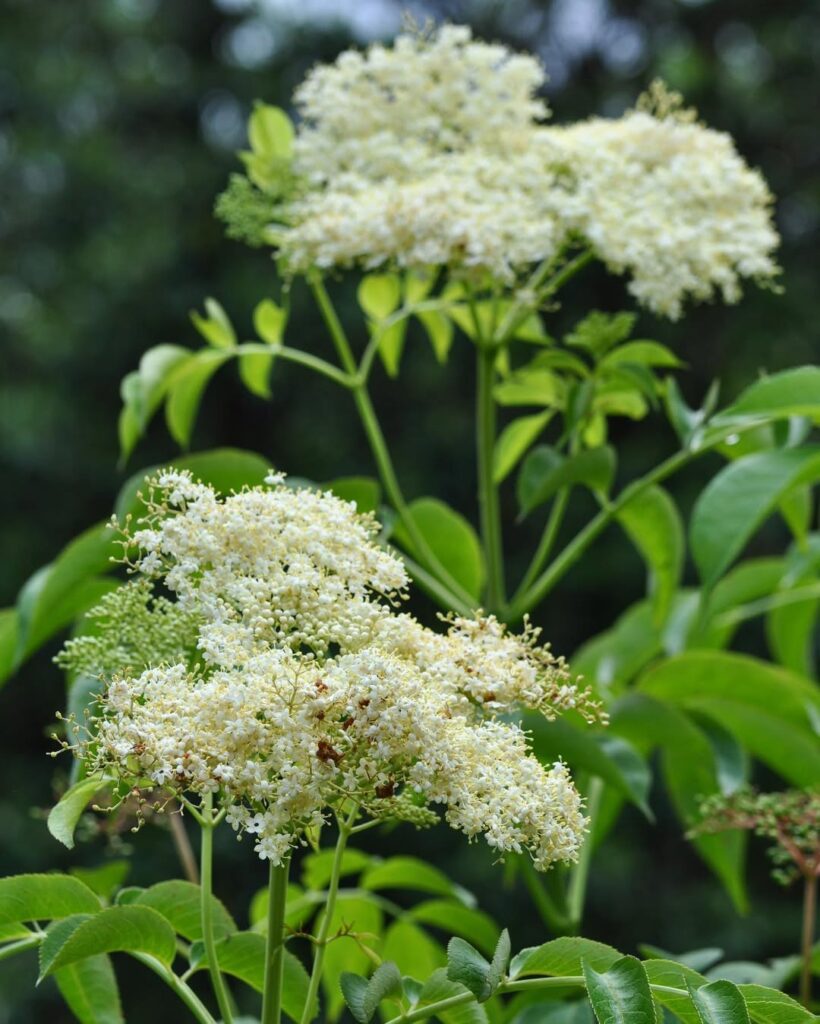
Elderberry (Sambucus Canadensis) is a versatile native shrub that serves as an excellent addition to Michigan landscapes. This multi-stemmed deciduous plant grows 5-12 feet tall with an attractive arching, rounded habit. In June-July, it produces clusters of fragrant white flowers that attract pollinators, followed by deep red-purple berries in late August that provide food for wildlife and humans alike.
This hardy shrub thrives across all Michigan regions and offers both ornamental and practical value. The berries can be used for making jams, pies, and wine, while the plant itself provides excellent deer and rabbit resistance. While elderberries are self-fertile, they benefit from cross-pollination with multiple varieties. Its adaptable nature and medium maintenance requirements make it ideal for edible landscapes and naturalized areas.
- Hardiness: USDA zones 4a-8b, suitable for all Michigan regions
- Light: Full sun (6+ hours daily) to partial shade (2-6 hours)
- Water: Medium-dry to medium-wet soil conditions
- Soil: Adaptable to clay, loam, sand, and high organic matter soils; prefers acid to neutral pH (below 8.0)
- Fertilizer: Medium maintenance requirements
- Pest/Disease Resistance: Deer and rabbit resistant
- Growth Rate: Medium growth rate with spreading, suckering habit
Serviceberry (Amelanchier Canadensis)
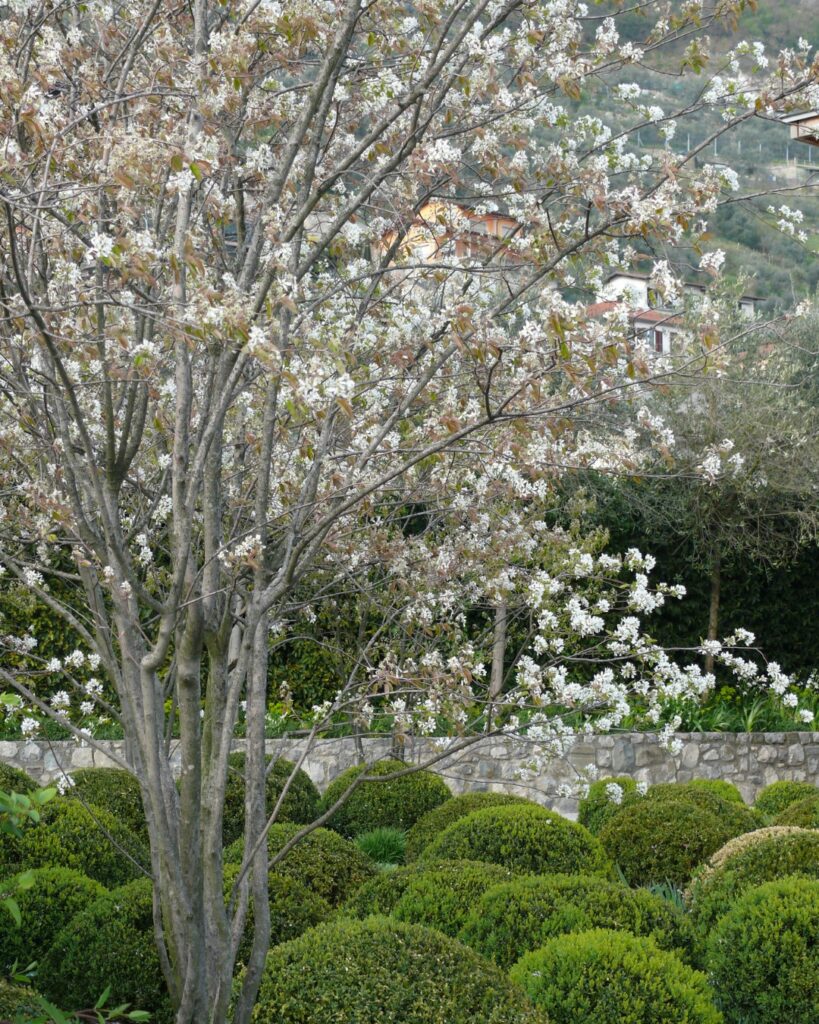
Serviceberry is a versatile native Michigan shrub or small tree that reaches 15-25 feet in height and width. This deciduous woody plant features smooth gray bark that develops attractive furrows with age, providing four-season interest. The upward-sloping branches create an elegant form that complements both natural and cultivated landscapes.
In early spring, serviceberry produces masses of delicate white flowers that coincide with the historic shad migration in New England rivers, giving rise to its “shadbush” nickname. By June, small purple berries develop that are beloved by birds and wildlife. The plant concludes the growing season with stunning apricot to reddish-bronze fall foliage, making it an exceptional choice for Michigan gardens seeking native alternatives to non-native ornamentals.
The berries, flowers, and bark all provide medicinal benefits, making serviceberry valuable beyond its ornamental qualities.
- Hardiness: Zones 2-6, thriving throughout Michigan including the Upper Peninsula
- Light: Full sun to partial shade, with best flowering in full sun locations
- Water: Prefers consistently moist soil conditions, especially swampland species
- Soil: Adaptable to various soil types, particularly suited to Michigan’s native conditions
- Fertilizer: Minimal requirements when grown in appropriate native soil conditions
- Pest/Disease Resistance: Generally resistant with few serious pest or disease issues
- Growth Rate: Moderate growth rate, establishing well in Michigan’s climate
Spicebush (Lindera Benzoin)
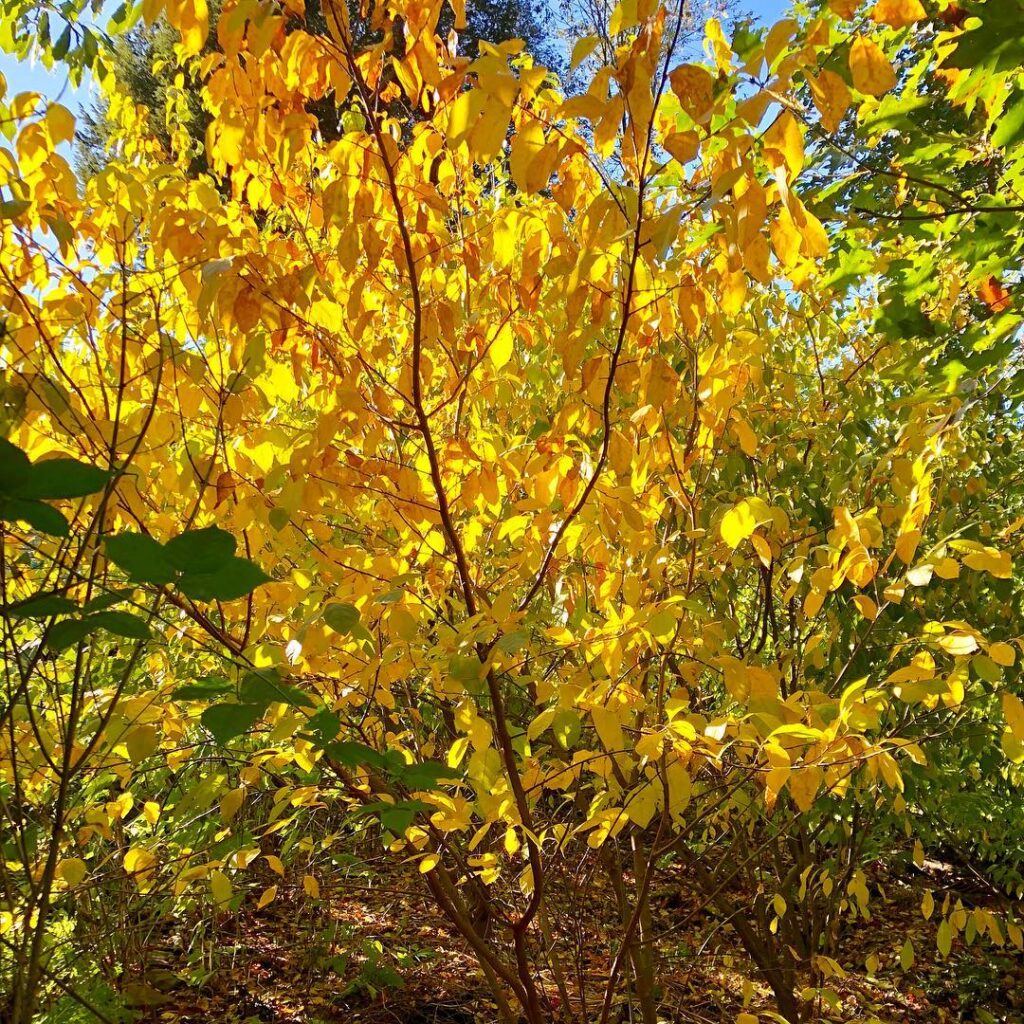
Spicebush (Lindera benzoin) is a versatile native shrub that thrives throughout Michigan’s diverse landscapes. This multi-stemmed deciduous plant typically reaches 4-12 feet in height and produces clusters of tiny yellow flowers in early spring before its aromatic leaves emerge. The shrub is particularly valuable for supporting local wildlife, serving as the primary host plant for the Spicebush Swallowtail butterfly.
In fall, Spicebush transforms the landscape with brilliant yellow foliage and bright red berries that provide food for birds and other wildlife. The plant’s adaptability to various light conditions makes it excellent for woodland gardens, naturalized areas, and native plant landscapes. Its aromatic leaves and edible berries have traditional uses as seasonings and teas. This member of the Lauraceae family shares botanical kinship with other aromatic plants like sassafras and bay laurel.
- Hardiness: USDA zones 4-9
- Light: Full sun to full shade; tolerates woodland understory conditions
- Water: Medium to moist; prefers consistent moisture but adapts to average conditions
- Soil: Sandy loam to clay; well-drained, adaptable to various soil types
- Fertilizer: Low requirements; benefits from organic matter but doesn’t need regular feeding
- Pest/Disease Resistance: Excellent resistance; few serious pest or disease issues
- Growth Rate: Moderate; establishes steadily once planted
Ninebark (Physocarpus Opulifolius)
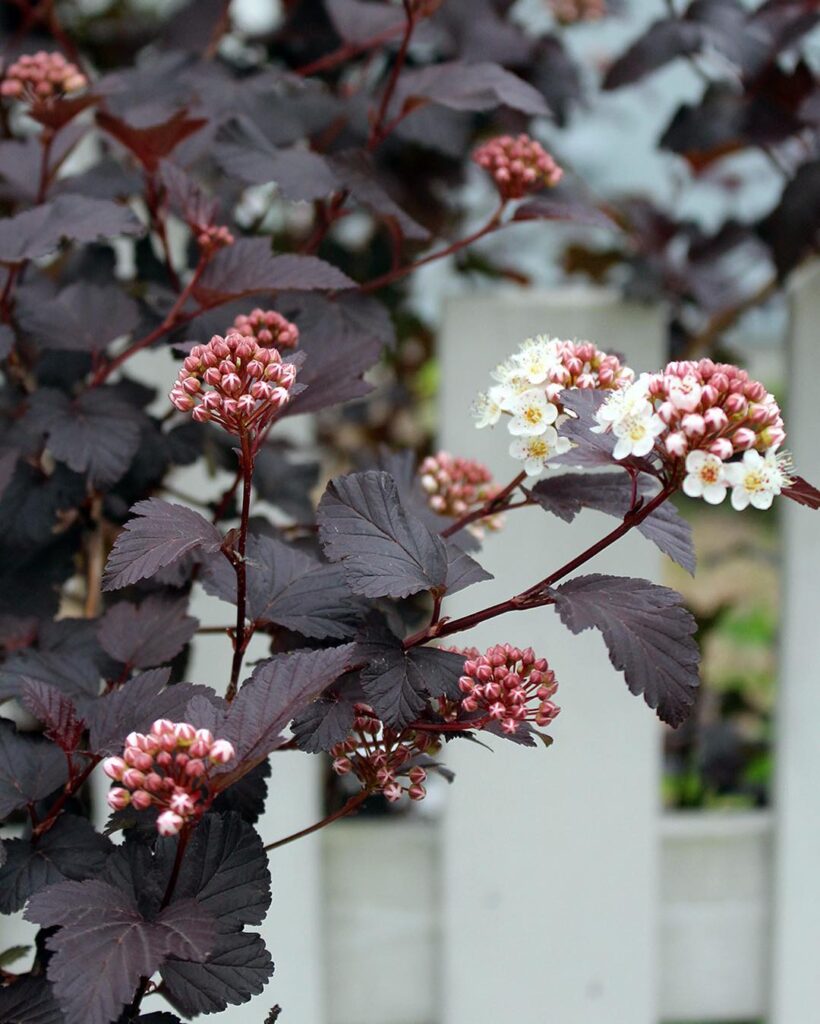
Ninebark (Physocarpus opulifolius) is Michigan’s premier native shrub, naturally thriving along lakeshores and riverbanks throughout the state. This deciduous beauty grows 5-10 feet tall with distinctive exfoliating bark that peels in layers, giving it its common name. Early summer brings clusters of white to pink flowers that support pollinators, followed by red fruits that attract songbirds.
This adaptable shrub excels in Michigan landscapes due to its remarkable tolerance of varying conditions. From full sun to shade and dry to wet soils, ninebark performs consistently while providing four-season interest. Its fast growth and hardy nature make it invaluable for native restoration projects and ornamental gardens alike. The arching branches provide excellent cover for birds throughout the year.
- Hardiness: USDA zones 2-8
- Light: Full sun to shade
- Water: Drought tolerant once established; adaptable from dry to wet conditions
- Soil: Clay and loamy soils; wide pH tolerance
- Fertilizer: No supplemental fertilizer needed
- Pest/Disease Resistance: Excellent resistance to common pests and diseases
- Growth Rate: Fast-growing; reaches maturity in one growing season
Red Osier Dogwood (Cornus Sericea)
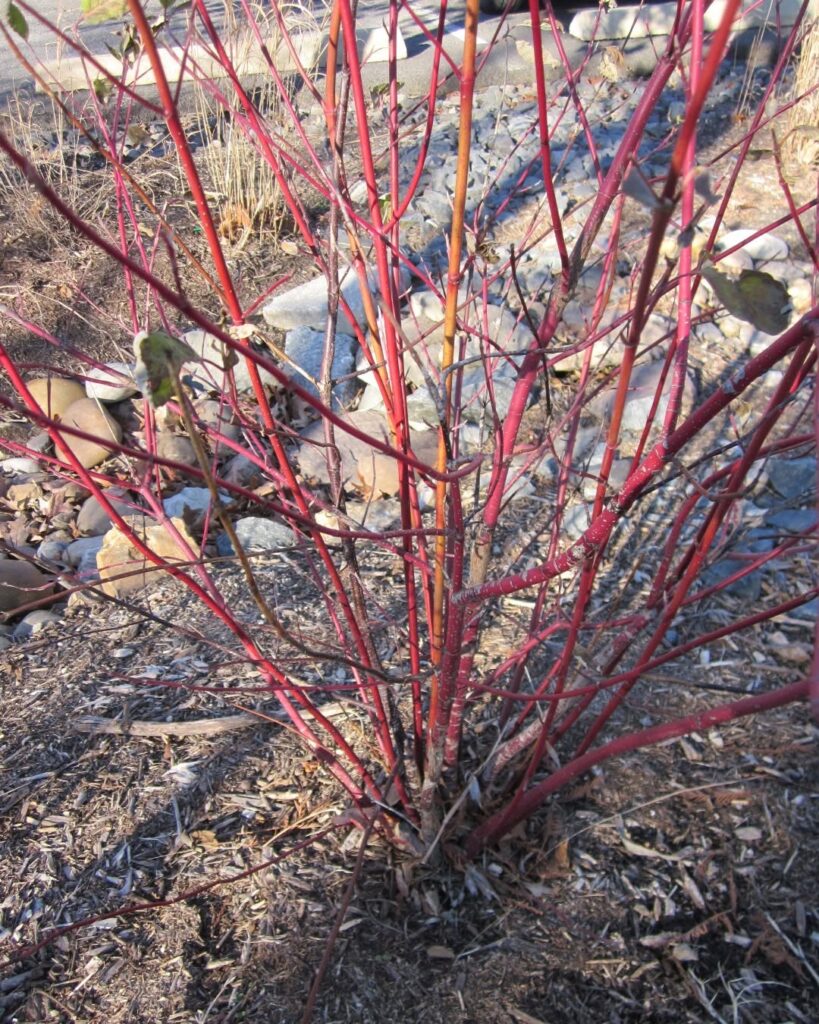
Red Osier Dogwood is a versatile native shrub that thrives throughout Michigan’s wetland environments. Growing 6-9 feet tall with a spreading, multi-stemmed form, this adaptable plant is prized for its striking red stems that provide exceptional winter interest. The shrub produces spring flowers that support pollinators and berries that feed wildlife, making it an excellent choice for naturalized landscapes, rain gardens, and restoration projects.
This hardy shrub excels in Michigan’s challenging conditions, from the Great Lakes region to the Upper Peninsula’s glacial plains. Its ability to stabilize soil along waterways while providing critical wildlife habitat makes it invaluable for ecological landscaping. Red Osier Dogwood readily forms dense thickets through underground stems and responds well to rejuvenation pruning to maintain vibrant stem color. The species is particularly valuable in southern shrub-carr communities, where it serves as one of the dominant shrub species in these successional wetland habitats.
- Hardiness: USDA zones 2-7, extremely cold hardy
- Light: Full sun to partial shade
- Water: Consistently moist to wet conditions, tolerates periodic flooding
- Soil: Moist, acidic to neutral soils; thrives in seasonally saturated areas
- Fertilizer: Generally not needed in natural settings
- Pest/Disease Resistance: Good resistance to most pests and diseases
- Growth Rate: Fast in ideal moist conditions
Selecting the Right Native Plants for Your Garden
How do you choose native plants that’ll actually thrive in your specific garden conditions? Start by evaluating your site’s moisture levels, soil type, and sunlight exposure. Match these conditions to plant requirements for better plant compatibility.
Consider maintenance needs next. Native species typically require less water, fertilizer, and care than non-natives. Focus on ecological benefits too—select plants that support local wildlife like monarch host plants or berry producers for birds.
Evaluate growth habits carefully. Check mature size, spreading behavior, and compatibility with existing plants. Always prioritize true Michigan natives to avoid introducing aggressive species. Michigan’s three regions each support different native species due to varying climate and soil conditions, so identify whether you’re in the southern Lower Peninsula, northern Lower Peninsula, or Upper Peninsula to select the most appropriate plants.
Frequently Asked Questions
When Is the Best Time to Plant Native Species in Michigan?
Like nature’s own calendar, you’ll find seasonal planting windows offer ideal conditions during spring and early fall. Plant your Michigan natives from September through October when cool air meets warm soil for vigorous establishment.
How Do I Control Invasive Species When Establishing Native Plants?
You’ll control invasive species by monitoring regularly and removing small patches quickly before they spread. Hand-pull seedlings, cut larger plants at their base, and replant disturbed areas immediately with native plants to prevent reestablishment.
What Are the Maintenance Requirements for Established Native Plant Gardens?
Once established, your native plant care requires minimal effort. You’ll need seasonal cleanup in spring, occasional weeding, and rare watering during droughts. Low maintenance frequency makes these gardens self-sustaining after year one.
Where Can I Purchase Native Michigan Plants and Seeds Locally?
You can purchase native Michigan plants from local nurseries like Wildtype Native Plant Nursery, Michigan Wildflower Farm, and Windy Rock Farm. Online retailers and MSU Extension also offer native seeds and plants.
How Long Does It Take for Native Plants to Become Established?
Native plants’ establishment timeline varies by planting method – you’ll see plant growth from seeds in 3-5 years, while plugs establish faster in 1-2 years, requiring consistent weed control throughout the process.
